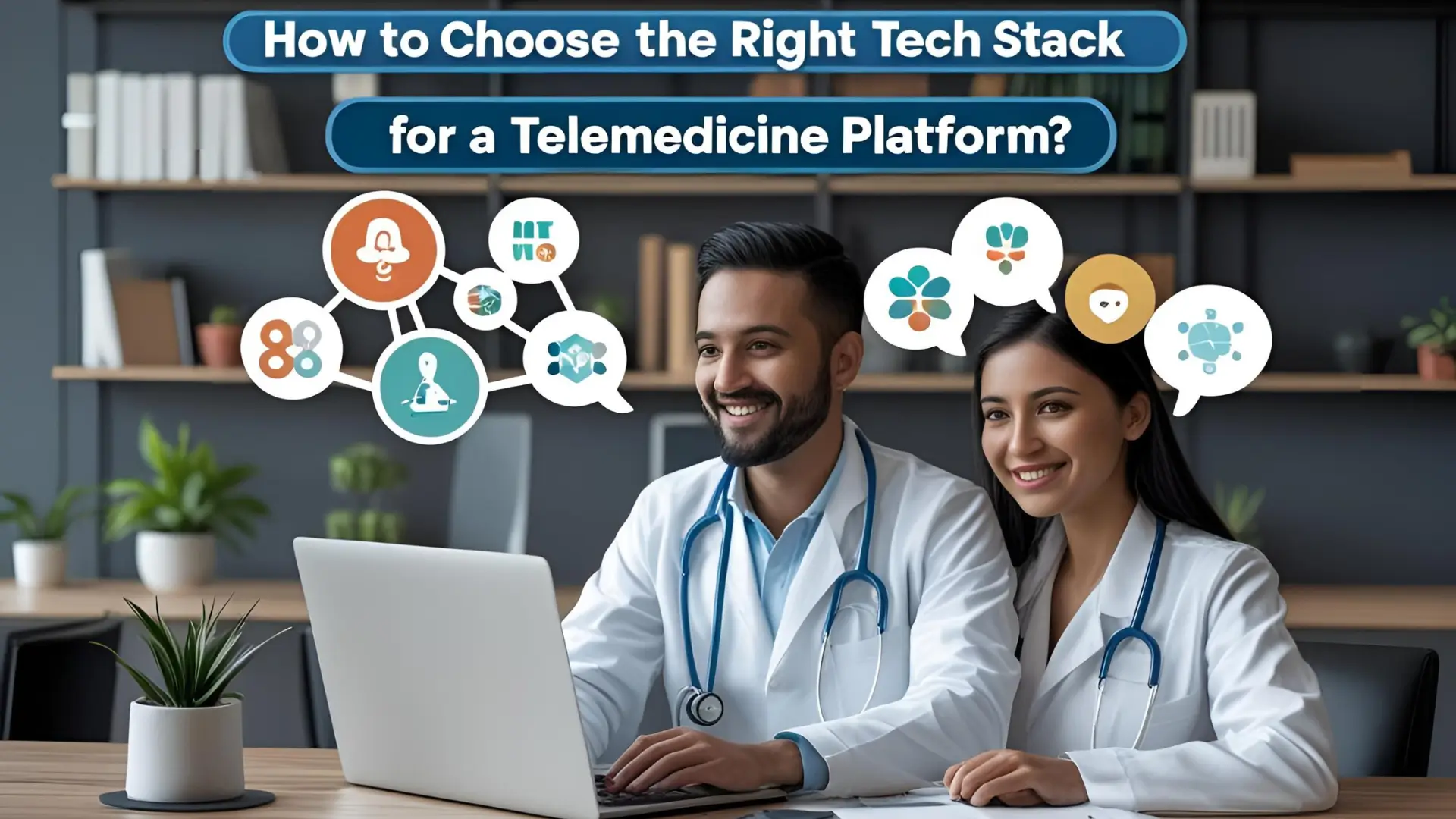The landscape of healthcare is undergoing a profound transformation, with telemedicine emerging as a cornerstone of modern patient care. From virtual consultations to remote monitoring, these platforms offer unparalleled convenience and accessibility. However, building a successful telemedicine platform isn’t just about integrating video calls; it demands a robust, secure, and scalable technology infrastructure – a well-chosen tech stack. For organizations seeking to build a truly unique and efficient solution, partnering with a custom software development agency can be a strategic move, ensuring the platform is tailored precisely to their needs.
For healthcare providers, startups, and established organizations looking to venture into or expand their telemedicine offerings, the decision of which technologies to adopt can be daunting. The right tech stack isn’t merely a collection of programming languages and databases; it’s the very foundation upon which your platform’s performance, security, compliance, and future growth will rest. This comprehensive guide will walk you through the critical considerations and key components necessary to select the ideal tech stack for your telemedicine platform, ensuring it’s not only efficient and user-friendly but also poised for long-term success.
Understanding the Unique Demands of Telemedicine
Before diving into specific technologies, it’s crucial to grasp the inherent complexities and stringent requirements of the telemedicine sector. Unlike many other digital products, healthcare platforms deal with highly sensitive patient data, demand unwavering reliability, and operate within a tightly regulated environment.
Key considerations include:
- Data Security and Privacy (HIPAA, GDPR, etc.): This is paramount. Patient health information (PHI) must be protected with the highest level of encryption, access controls, and compliance measures. Any tech stack chosen must inherently support these regulations or integrate seamlessly with tools that do.
- Scalability: A successful telemedicine platform needs to handle a fluctuating number of users, from a handful during initial launch to potentially millions as it grows. The tech stack must be able to scale both horizontally (adding more servers) and vertically (upgrading existing servers) without compromising performance.
- Real-time Communication: Video conferencing, secure messaging, and real-time data sharing are at the core of telemedicine. The chosen technologies must ensure low-latency, high-quality, and secure communication channels.
- Integration Capabilities: Telemedicine platforms rarely operate in isolation. They often need to integrate with Electronic Health Records (EHR) systems, Electronic Medical Records (EMR) systems, lab results, payment gateways, and wearable devices.
- Performance and Reliability: Patients and providers depend on these platforms for critical health interactions. Slow loading times, glitches, or downtime can have serious consequences. The tech stack must guarantee high performance and uptime.
- User Experience (UX): The platform needs to be intuitive and accessible for diverse users, including patients who may not be tech-savvy and healthcare professionals with limited time. A seamless and user-friendly interface is vital for adoption and retention.
Core Components of a Telemedicine Tech Stack
A typical telemedicine platform’s tech stack can be broken down into several essential layers:
1. Frontend Development (User Interface)
This is what your users interact with – the web application and mobile apps. The choice here heavily influences the user experience, development speed, and cross-platform compatibility.
- For Web Applications:
- React.js: A popular JavaScript library for building dynamic and interactive user interfaces. Known for its component-based architecture and strong community support, it’s a solid choice for complex UIs.
- Angular: A comprehensive framework for building robust, large-scale web applications. It offers a structured approach and rich features, making it suitable for enterprise-level telemedicine platforms.
- Vue.js: A progressive JavaScript framework that is easy to learn and integrate. It’s often chosen for its flexibility and performance, especially for projects requiring rapid development.
- For Mobile Applications:
- React Native: A popular framework for building cross-platform mobile applications using JavaScript. It allows for a single codebase for both iOS and Android, significantly reducing development time and cost. While excellent for many scenarios, consider potential limitations for highly complex, native-feature-dependent applications.
- Flutter: Google’s UI toolkit for building natively compiled applications for mobile, web, and desktop from a single codebase. Known for its expressive UI and fast development, it’s gaining significant traction in the healthcare space.
- Native Development (Swift/Kotlin): For ultimate performance, device-specific features, and highly customized user experiences, developing separate native applications for iOS (Swift) and Android (Kotlin) remains the gold standard. This typically involves higher development costs and longer timelines.
SEO Tip: A fast, responsive frontend contributes directly to better user engagement and lower bounce rates, both of which are positive SEO signals.
2. Backend Development (Server-Side Logic)
The backend is the engine of your telemedicine platform, handling data storage, processing, business logic, and API integrations. When seeking comprehensive expertise across both frontend and backend, businesses often turn to providers of full stack development services to ensure seamless integration and optimal performance.
- Node.js: A JavaScript runtime built on Chrome’s V8 JavaScript engine, known for its non-blocking, event-driven architecture. Ideal for real-time applications like telemedicine, handling concurrent connections efficiently. Popular frameworks include Express.js.
- Python: With frameworks like Django and Flask, Python is highly versatile and renowned for its readability and extensive libraries. It’s an excellent choice for data processing, analytics, and building robust APIs, especially when AI/ML integrations are planned.
- Java: A highly mature and scalable language with frameworks like Spring Boot. Java is favored for large-scale enterprise applications demanding high performance, security, and stability. Its strong typing and robust ecosystem are well-suited for complex healthcare systems.
- Ruby on Rails: A productive framework that emphasizes convention over configuration, allowing for rapid development. While perhaps less common in new telemedicine projects compared to Node.js or Python, it can still be a viable option for certain needs.
SEO Tip: A well-optimized backend ensures fast data retrieval and processing, directly impacting page load times and overall site performance, which Google favors.
3. Database Management
Choosing the right database is crucial for storing sensitive patient data, appointment schedules, medical history, and more.
- Relational Databases (SQL):
- PostgreSQL: A powerful, open-source object-relational database system known for its robust features, data integrity, and extensibility. It’s a strong contender for healthcare applications due to its reliability and support for complex queries.
- MySQL: Another popular open-source relational database, widely used for web applications. It offers good performance and scalability but may require more careful schema design for complex healthcare data compared to PostgreSQL.
- NoSQL Databases:
- MongoDB: A flexible, document-based NoSQL database, ideal for handling large volumes of unstructured or semi-structured data. Its scalability and agility can be beneficial for rapidly evolving telemedicine platforms, especially when dealing with diverse data types.
- Firebase: A Google-backed platform offering a real-time NoSQL database. It’s often chosen for its ease of use, real-time synchronization, and integrated authentication, making it suitable for applications requiring rapid data updates.
Security Note: Regardless of the database type, robust encryption (at rest and in transit), access controls, and regular backups are non-negotiable for HIPAA and GDPR compliance.
4. Cloud Infrastructure and Hosting
Cloud providers offer scalable, secure, and cost-effective solutions for deploying and managing telemedicine platforms.
- Amazon Web Services (AWS): The leading cloud provider, offering a vast array of services, including compute (EC2), storage (S3), databases (RDS, DynamoDB), and specialized healthcare services like AWS HealthLake for HIPAA-compliant EHR data storage.
- Microsoft Azure: Another strong contender, providing a comprehensive suite of cloud services, including Azure Compute, Azure Storage, and Azure API for FHIR (Fast Healthcare Interoperability Resources) for seamless healthcare data exchange.
- Google Cloud Platform (GCP): Offers robust infrastructure, machine learning capabilities (like Google Cloud Healthcare API for AI-powered medical data analysis), and strong security features, making it a competitive choice for telemedicine.
SEO Tip: Hosting on a reliable cloud provider with a global presence can improve site speed for users across different geographical locations, which benefits SEO.
5. Essential Third-Party Integrations and APIs
No telemedicine platform is complete without integrating various specialized services.
- Video Conferencing APIs:
- WebRTC: An open-source project enabling real-time communication capabilities directly in web browsers and mobile applications without plugins. It’s a fundamental technology for video calls.
- Twilio: A leading cloud communications platform offering robust APIs for video, voice, and messaging, simplifying the integration of real-time communication features.
- Agora: Provides real-time engagement APIs for video, voice, and live interactive streaming, known for its high quality and scalability.
- Zoom SDK: For platforms desiring to leverage the familiarity and robust features of Zoom within their own application.
- EHR/EMR Integration: Essential for seamless data flow between your platform and existing healthcare systems. Look for FHIR (Fast Healthcare Interoperability Resources) compliant APIs.
- Payment Gateways: Securely process patient payments (e.g., Stripe, PayPal, Razorpay).
- Identity Verification & Authentication: Implement robust user authentication, including multi-factor authentication (MFA).
- Prescription Management: APIs to connect with pharmacies and manage prescriptions.
- Diagnostic & AI Tools: Integration with AI symptom checkers, diagnostic imaging platforms, or predictive analytics tools.
SEO Tip: While direct SEO impact is minimal, seamless integrations improve user experience and functionality, indirectly leading to higher user satisfaction and potentially more positive reviews, which can aid SEO.
Key Factors to Consider When Making Your Choice
Beyond the individual components, several overarching factors should guide your tech stack decision:
- Regulatory Compliance (HIPAA, GDPR, etc.): This cannot be stressed enough. Every component of your tech stack must either be inherently compliant or capable of being configured to meet stringent healthcare regulations regarding data privacy, security, and audit trails.
- Budget and Timeline: Different technologies and development approaches (native vs. cross-platform, custom development vs. SaaS solutions) have varying cost and time implications. Define your budget and desired time-to-market clearly.
- Team Expertise: Your development team’s existing skill set should play a significant role. Leveraging their expertise can accelerate development and reduce learning curves. If new technologies are introduced, ensure adequate training or consider hiring specialists.
- Scalability and Future-Proofing: Think long-term. Will the chosen stack support anticipated growth in users, features, and data volume? Can it easily integrate new technologies as they emerge?
- Community Support and Documentation: Robust community support, extensive documentation, and active development for chosen technologies are invaluable for troubleshooting, finding solutions, and staying updated.
- Open-Source vs. Proprietary: Open-source technologies offer flexibility and cost savings but may require more in-house expertise. Proprietary solutions often come with dedicated support and integrated features but can incur licensing fees.
- Security Features: Evaluate the inherent security features of each technology, including encryption protocols, authentication mechanisms, and vulnerability management.
- Maintainability: A well-chosen tech stack is easier to maintain, debug, and update over time, reducing long-term operational costs.
Native vs. Cross-Platform for Mobile Apps: A Deeper Dive
This is a recurring dilemma for telemedicine platforms.
- Native Development (Swift for iOS, Kotlin for Android):
- Pros: Optimal performance, access to all device-specific features (e.g., advanced biometrics, specific hardware sensors for remote monitoring devices), highly customizable UI/UX, best for complex applications requiring high responsiveness.
- Cons: Higher development costs (two separate codebases), longer development time, requires specialized skill sets.
- Cross-Platform Development (React Native, Flutter):
- Pros: Faster time-to-market, lower development costs (single codebase), easier maintenance, broader developer talent pool.
- Cons: May have performance limitations for very demanding applications, limited access to some native device features (though increasingly less so), potential for a less “native” feel in the UI/UX.
Recommendation: For an MVP (Minimum Viable Product) or basic telemedicine features (scheduling, video calls, chat), cross-platform solutions can be highly effective for rapid deployment and testing the market. For platforms requiring deep integration with medical devices, high-fidelity real-time data streaming, or highly customized user experiences, native development might be a better long-term investment.
Conclusion
Choosing the right tech stack for your telemedicine platform is a strategic decision that will profoundly impact its success. It’s a complex puzzle with many interlocking pieces, each demanding careful consideration. By prioritizing security, scalability, performance, and user experience, and by aligning your technology choices with your specific business goals and regulatory requirements, you can lay a strong foundation for a telemedicine platform that not only meets the current demands of digital healthcare but is also ready to adapt and thrive in the future.
The healthcare industry is dynamic, and technology continues to evolve rapidly. Invest in a tech stack that is not only robust today but also flexible enough to incorporate future innovations like AI-powered diagnostics, IoT-driven remote patient monitoring, and blockchain for enhanced data security.
Ready to transform healthcare delivery? Whether you need tailored solutions from a software development services provider or comprehensive guidance, partnering with experienced professionals who understand the nuances of telemedicine development can help you craft a secure, scalable, and user-centric platform. Contact us today for a personalized consultation and let’s build the future of healthcare, together.



